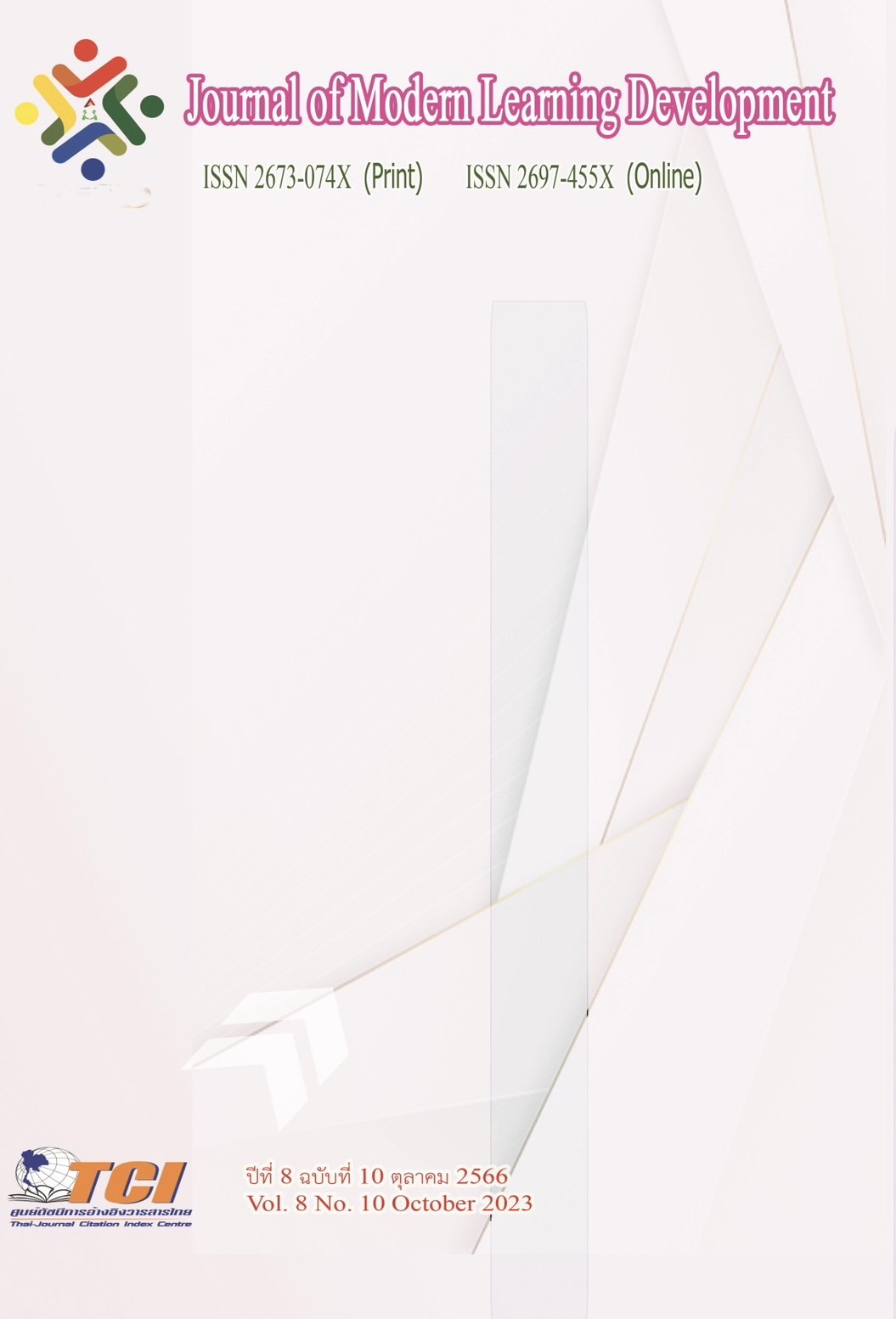Development of Thai Language Learning Activities With Brain – Based Learning Management on Types of Words for Prathom 6 Students
Main Article Content
Abstract
The objectives of this research were (1) to development of thai language learning activities with brain – based learning management on types of words for prathom 6 students (2) to compare pre- and post-study achievements using a thai language learning activities with brain – based learning management on types of words for prathom 6 students and (3) to study the satisfaction of prathom 6 students towards thai language learning activities with brain – based learning management on types of words. The populations used in this research were prathom 6 students in Songfangyomsamakkee group KongKrailas District Sukhothai Province there are 12 schools with 12 classrooms. The samples used
in the research were prathom 6 students. The research is conducted on the 2nd semester in 2022 at Bannong sampaya school . which each room has 7 students by using a Simple Random Sampling.
The research instrument consists of (1) Thai language learning activities with brain – based learning management on types of words for prathom 6 students 7 students 14 hours. (2) Thai language learning achievement test types of words is a multiple-choice type, 4 options, 30 items and (3) Assessment form of student satisfaction with Thai language learning activity set with brain-based learning management on types of words. The statistics used to analyze the data were mean, standard deviation, and t-test dependent samples
The following were the results (1) the results of the development of the Thai language learning activity package; With a brain-based learning management on types of words for Prathom 6 students who were examined by experts, overall, it was appropriate at the highest level. (2) Comparison results Achievement before school and after school by using a set of Thai language learning activities With the brain-based learning management on types of words for Prathom 6 students, their post-test scores were significantly higher than before at the .05 level and (3) The students were satisfied with their learning using the Thai language learning activity package. With the brain-based learning management, the subjects, types of words, were satisfied at a high level. ( = 4.25, S.D. = 0.16 )
Article Details
References
กระทรวงศึกษาธิการ. (2546). การจัดการเรียนรู้กลุ่มสาระการเรียนภาษาไทย. กรุงเทพมหานคร: คุรุสภาลาดพร้าว.
เขมจิรา เครือตา. (2561). การพัฒนาชุดกิจกรรมการเรียนรู้ตามแนวคิดใช้สมองเป็นฐาน เพื่อส่งเสริมความสามารถในการเขียนเชิงสร้างสรรค์ กลุ่มสาระการเรียนรู้ภาษาไทยสำหรับนักเรียนชั้น ประถมศึกษาปีที่ 3. การค้นคว้าอิสระ กศ.ม. สาขาวิชาวิจัยและประเมินผลการศึกษา. บัณฑิตวิทยาลัย: มหาวิทยาลัยนเรศวร.
ชัยยงค์ พรหมวงศ์. (2523). ระบบสื่อการสอน. กรุงเทพมหานคร: จุฬาลงกรณ์มหาวิทยาลัย.
ทิศนา แขมมณี. (2559). ศาสตร์การสอน : องค์ความรู้เพื่อการจัดกระบวนการเรียนรู้ที่มีประสิทธิภาพ. (พิมพ์ครั้งที่ 20). กรุงเทพมหานคร: สำนักพิมพ์แห่งจุฬาลงกรณ์มหาวิทยาลัย.
นารถนารี อินฒะสอน. (2550). การเปรียบเทียบผลสัมฤทธิ์ทางการเรียนวิชาภาษาไทย เรื่อง คำและชนิดของคำ ของนักเรียนชั้นประถมศึกษาปีที่ 6 ที่ได้รับการสอนโดยการเรียนรู้แบบร่วมมือเทคนิค TAI กับการสอนปกติ. วิทยานิพนธ์ กศ.ม. บัณฑิตวิทยาลัย: มหาวิทยาลัยศิลปากร.
บุญชม ศรีสะอาด. (2553). การวิจัยเบื้องต้น. (พิมพ์ครั้งที่ 6). กรุงเทพมหานคร: สุวีริยาสาส์น.
ลภัลดา จูเมฆา. (2555). การพัฒนาชุดกิจกรรมเพื่อส่งเริมความสามารถในการเขียนเชิงสร้างสรรค์ สำหรับนักเรียนชั้นประถมศึกษาปีที่ 6. วิทยานิพนธ์ กศ.ด. บัณฑิตวิทยาลัย: มหาวิทยาลัยนเรศวร.
สถาบันทดสอบการศึกษาแห่งชาติ. (2565). รายงานผลการทดสอบทางการศึกษาระดับชาติขั้นพื้นฐาน (O-NET) ชั้นประถมศึกษาปีที่ 6. ออนไลน์.สืบค้นเมื่อ 7 กรกฎาคม 2565. แหล่งที่มา http://www.newOnetresult.niets.or.th/AnnouncementWeb/Login.aspx
สุคนธ์ สินธพานนท์. (2553). นวัตกรรมการเรียนการสอนเพื่อพัฒนาคุณภาพของเยาวชน. (ฉบับปรับปรุงครั้งที่ 2) . กรุงเทพมหานคร: ห้างหุ้นส่วนจำกัด 9119 เทคนิคพริ้นติง.
ไสว ฟักขาว. (2551). หลักการสอนสำหรับการเป็นครูมืออาชีพ. กรุงเทพมหานคร: เอมพันธ์.


